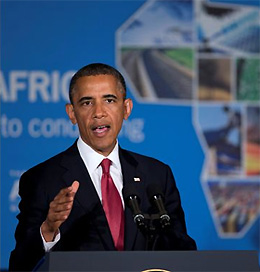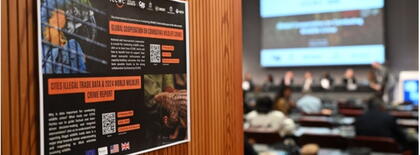For use of the media only;
not an official document.
 Geneva, 2 July 2013 – The Secretariat of the Convention on International Trade in Endangered Species of Wild Fauna and Flora (CITES) welcomes the Executive Order on Combating Wildlife Trafficking issued by the President of the United States, Barack Obama, on 1 July 2013. The Executive Order addresses both its domestic and international response to the current surge in wildlife trafficking.
Geneva, 2 July 2013 – The Secretariat of the Convention on International Trade in Endangered Species of Wild Fauna and Flora (CITES) welcomes the Executive Order on Combating Wildlife Trafficking issued by the President of the United States, Barack Obama, on 1 July 2013. The Executive Order addresses both its domestic and international response to the current surge in wildlife trafficking.
The Executive Order establishes a Presidential Task Force on Wildlife Trafficking, to be co-chaired by the Secretary of State, Secretary of the Interior, and the Attorney General (Co-Chairs), or their designees, who shall report to the President through the National Security Advisor, with certain tasks assigned to it.
"This Executive Order sends a very powerful message both domestically and internationally on the need to treat wildlife crime as a serious crime on a par with narcotics and arms trafficking. The offer of financial and technical assistance to affected range States to tighten laws and strengthen capacity to combat wildlife trafficking, including the targeted training of front-line enforcement officers, is much needed" said Mr John E. Scanlon, CITES Secretary-General.
The United States is also working with the International Consortium on Combating Wildlife Crime (ICCWC) and other interested partners to support the creation of a global network of regional and national Wildlife Enforcement Networks to improve communication and strengthen response actions across enforcement agencies globally. ICCWC convened the world's Wildlife Enforcement Networks for the first time in the margins of CITES CoP16, with the report being released this week.
Background and key excerpts from the Executive Order
The Executive Order builds upon the decisions and resolutions taken on wildlife crime by APEC, the UN Conference on the Sustainable Development, the CITES Conference of the Parties, the UN Commission on Crime Prevention and Criminal Justice, and the G8 Summit, as well as the UN Secretary General's report to the Security Council on the activities of the United Nations Regional Office for Central Africa and on the Lord’s Resistance Army-affected areas.
The Executive Order notes that:
"Poaching operations have expanded beyond small-scale, opportunistic actions to coordinated slaughter commissioned by armed and organized criminal syndicates. The survival of protected wildlife species such as elephants, rhinos, great apes, tigers, sharks, tuna, and turtles has beneficial economic, social, and environmental impacts that are important to all nations".
The Executive Order goes on to provide that:
"In order to enhance domestic efforts to combat wildlife trafficking, to assist foreign nations in building capacity to combat wildlife trafficking, and to assist in combating transnational organized crime, executive departments and agencies (agencies) shall take all appropriate actions within their authority, including the promulgation of rules and regulations and the provision of technical and financial assistance, to combat wildlife trafficking" in line with stated objectives.
The Executive Order also states that the United States shall seek to reduce the demand for illegally traded wildlife, both at home and abroad, while allowing legal and legitimate commerce involving wildlife.
Background information on wildlife trafficking
Poaching levels have increased in all African subregions, with central Africa continuing to display the highest levels of illegal killing of elephants in any subregion in Africa or Asia. Wildlife rangers who are serving in the front line are often quite literally being outgunned. Wildlife crime has become a serious threat to the security, political stability, economy, natural resources and cultural heritage of many countries. The extent of the response required to address this threat effectively is often beyond the sole remit of environmental or wildlife law enforcement agencies, or even of one country or region alone.
The Fact Sheet also notes that the US will work with the International Consortium on Combatting Wildlife Crime (ICCWC). For more information on ICCWC see: /eng/prog/iccwc.php
ICCWC hosted the first meeting of regional wildlife enforcement networks at the CITES CoP: https://cites.org/eng/news/pr/2013/20130307_wen.php
ICCWC also hosted a Ministerial session on transboundary wildlife crime at the CITES CoP with the report available here: https://cites.org/eng/cop/16/inf/E-CoP16i-54.pdf
Read more:
- US Senate Foreign Relations Committee Hearing
- Secretary Clinton's 'Call for Action' on illicit wildlife trade
- Rio+20 on CITES and wildlife crime
- APEC on wildlife crime
- CITES Conference of the Parties on wildlife crime
- UN Commission on Crime Prevention and Criminal Justice resolution on wildlife crime
- UK Royal Family efforts to combat wildlife crime
- G8 Summit 2013 outcomes on wildlife crime
- UN Security Council and the LRA and illicit ivory trade
- CITES at 40 Marks a Major Decision Point for Sharks, Trees, Snakes, Turtles and other Wildlife Species
- CITES Secretary-General calls for urgent action to protect elephants in the Dzanga-Sanga National Park from armed groups
- CITES Secretary-General expresses grave concern over reports of mass elephant killings in Cameroon
Note to editors:
For more information, contact Juan Carlos Vasquez at +41 22 917 8156 or juan.vasquez [at] cites.org (juan[dot]vasquez[at]cites[dot]org).
About CITES
With 178 Member States, CITES remains one of the world's most powerful tools for biodiversity conservation through the regulation of trade in wild fauna and flora. Thousands of species are internationally traded and used by people in their daily lives for food, housing, health care, ecotourism, cosmetics or fashion.
CITES regulates international trade in close to 35,000 species of plants and animals, including their products and derivatives, ensuring their survival in the wild with benefits for the livelihoods of local people and the global environment. The CITES permit system seeks to ensure that international trade in listed species is sustainable, legal and traceable.
CITES was signed in Washington D.C. on 3 March 1973.
Learn more about CITES by visiting www.cites.org or connecting to:
www.facebook.com/cites
www.twitter.com/citesconvention
www.youtube.com/citesvd
www.flickr.com/cites



